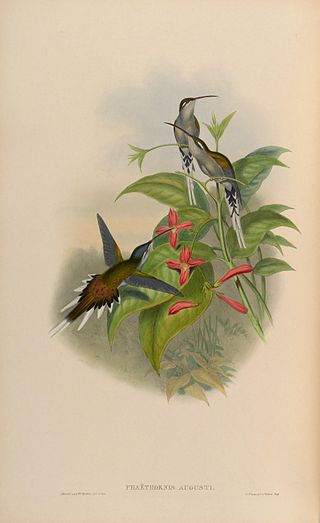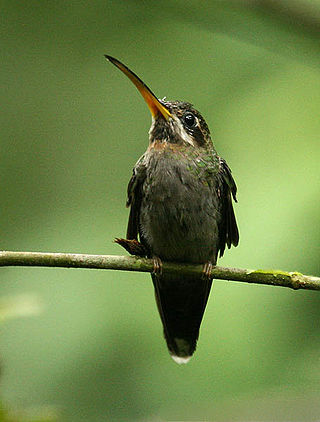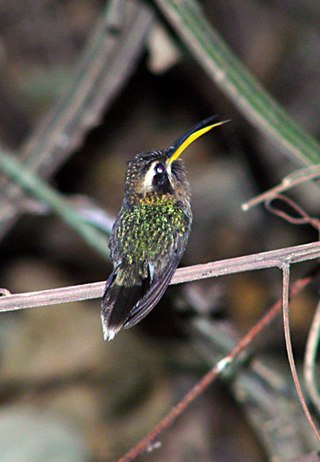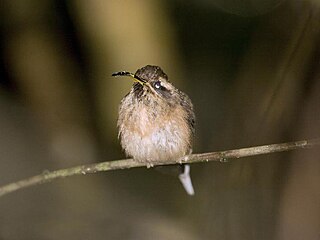
The saw-billed hermit is a hummingbird in the family Trochilidae. It is endemic to Brazil.

The sooty-capped hermit is a species of bird in the family Trochilidae, the hummingbirds. It is found in Brazil, Colombia, French Guiana, Guyana, Suriname, and Venezuela.

The long-billed hermit is a bird in the family Trochilidae, the hummingbirds. It is found from central Mexico south through Central America, Colombia and Ecuador into Peru.

The long-tailed hermit is a large hummingbird that is a resident breeder in Venezuela, the Guianas, and north-eastern Brazil. This species was formerly referred to as the eastern long-tailed hermit.

The band-tailed barbthroat is a medium-sized hummingbird that is found from southeastern Guatemala and Belize to western Ecuador and western Venezuela.

The bronzy hermit is a species of hummingbird in the family Trochilidae. It is found in Colombia, Costa Rica, Ecuador, Honduras, Nicaragua, and Panama.

The broad-tipped hermit is a species of hummingbird in the family Trochilidae. It is endemic to Brazil.

The pale-bellied hermit is a species of hummingbird in the family Trochilidae. It is found in Colombia, Panama, and Venezuela.

The black-throated hermit is a species of hummingbird in the family Trochilidae. It is found in Colombia, Ecuador, and Peru.

The straight-billed hermit is a species of bird in the family Trochilidae, the hummingbirds. It is found in Brazil, Colombia, Ecuador, French Guiana, Guyana, Peru, Suriname, and Venezuela.

The scale-throated hermit is a species in the hummingbird family Trochilidae. It is found in Argentina, Brazil, and Paraguay.

The white-bearded hermit is a species of hummingbird in the family Trochilidae. It is found in Bolivia, Brazil, Colombia, Ecuador, Peru, and Venezuela.

The minute hermit is a tiny species of hummingbird in the family Trochilidae. It is endemic to Brazil.

The great-billed hermit is a species of hummingbird in the family Trochilidae. It is found in Bolivia, Brazil, Colombia, Ecuador, French Guiana, Peru, Suriname, and Venezuela.

The needle-billed hermit is a species of hummingbird in the family Trochilidae. It is found in Bolivia, Brazil, and Peru.

The streak-throated hermit, also known as the Rupurumi hermit, is a species of hummingbird in the family Trochilidae. It is found in Brazil, Colombia, Guyana, and Venezuela.

The dusky-throated hermit is a species of hummingbird in the family Trochilidae. It is endemic to Brazil.

The buff-bellied hermit is a species of bird in the family Trochilidae, the hummingbirds. It is found in Bolivia and Brazil.

The planalto hermit is a species of bird in the family Trochilidae, the hummingbirds. It is found in Argentina, Bolivia, Brazil, Paraguay, and Peru.

The Mexican hermit is a species of hummingbird in the family Trochilidae. It is endemic to Mexico.























